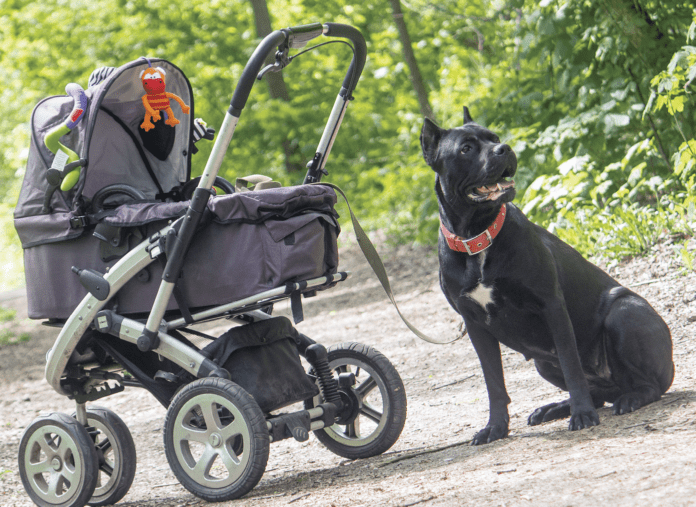You’re walking your new baby in the carriage with the dog alongside, and a neighbor sees you and comes over to have a peek. Your dog gives a low growl, and you think it’s adorable that she seems to want to protect your young child, so you laugh lightheartedly while petting her. Unfortunately, it is no laughing matter. And it also may very well have nothing to do with an instinct for nannying.
There are many reasons a dog may growl when someone approaches a family member, adult or child, and they have nothing to do with protection. The first thing to consider is a medical problem. Pain and discomfort lower a dog’s threshold for anxiety and irritability. If your dog’s behavior has changed recently, it is important to first consult your pup’s veterinarian to make sure there is nothing medically amiss.
Of course, dogs may growl for behavior reasons as well, and protectiveness toward the new family member is only one of many behavioral possibilities. Here’s another: If your dog has shown fear of people or fear-based aggression toward people prior to the baby’s arrival, she may be demonstrating fear aggression. That is to say, she may be growling simply because she perceives that someone is approaching her when their aim is to approach the child. Fearful dogs are at risk of being triggered by people approaching quickly, using funny “kid-friendly” voices, or bending over. Many behaviors that people exhibit with young children are unfamiliar and thus frightening to dogs, especially if the dogs are unused to being around children. They may even be less comfortable with their own human guardians when those family members are with the baby. After all, they have never seen “Mom” and “Dad” in this new light before.
Even dogs with no history of fear or anxiety around strangers may be more anxious when a baby comes home. Dogs are very routine-oriented, and changes that may seem small to us could rock their world. And let’s face it; a new baby is not a small change. Babies can bring some major disruptions in a dog’s life. Sleep schedule, walks, play time, meals, and attention all may be altered. Such changes can trigger anxiety and uncertainty, which in turn can lead to increased reactivity and irritability.
There are instances in which dogs will protect children or other family members, but it is not as common as most people think. In fact, even for dogs that are very attached to the baby, you may be seeing what behaviorists call resource guarding, which is possessive aggression, not protective aggression. Instead of “Back off, you are dangerous,” the dog is saying, “Back off, this baby is mine.”
Safety First
Regardless of the reason for your dog’s behavior, you can help.
Safety with Visitors
Short run. If your dog is acting aggressively when people visit, perhaps by growling, have the dog in another room, behind a gate, or on a leash. That way, your visitors can interact comfortably with the baby.
- Longer-term solution. Teach your dog to go to a designated place, such as her mat or dog bed, when people come to visit. Reward her for remaining calm in her place so she wants to stay.
Safety on Walks
Short run. Consider walking the dog separately from walking the baby if you would like people to be able to look at and/or interact with the child. The dog may also have a better time if she is not worrying with the baby present.
- Longer-term solution. Teach your dog to sit next to you and give you her attention whenever someone comes up to talk to you or your child. Reward her at intervals for staying there.
A trainer can be a great help with these skills. But be sure to find a force-free trainer with the proper qualifications. No yanking the leash, and nothing else that could potentially cause pain or fear. You may want to ask if the person is a member of the Association of Pet Dog Trainers (www.apdt.com). That organization promotes positive, no-punishment training only and in fact may be able to help you locate an exclusively positive trainer in your area.
Other ways to help your dog adjust to the baby
Consistency. It’s important to be as consistent as possible in arranging your dog’s daily schedule. Keep feeding times regular, and make sure to set aside time for cuddling, training, play, and of course, exercise. Consistency combined with the opportunity to tire her body will also help calm her mind. If you don’t have time to provide the exercise your dog needs, consider hiring a dog walker or sending her to a high-quality play group.
Compassion. Keep in mind that dogs have a tough time with change. Be patient with her. The experience is new for her, too! If she does something wrong, a reprimand is unlikely to be helpful. Instead, think of giving her a cue to do something incompatible with the unwanted behavior (like sitting if she is jumping up). And reward her for making the better choice. Love and training, along with consistency, will get most dogs through the transition.
If your dog does not adjust, or if she exhibits potentially dangerous behaviors, contact your veterinarian for a referral to a veterinary behaviorist.





